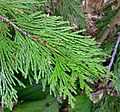Calocedrus decurrens
| Calocedrus decurrens | |
|---|---|
 | |
| Conservation status | |
| Scientific classification | |
| Kingdom: | Plantae |
| Division: | Pinophyta |
| Class: | Pinopsida |
| Order: | Pinales |
| Family: | Cupressaceae |
| Genus: | Calocedrus |
| Species: | C. decurrens |
| Binomial name | |
| Calocedrus decurrens (Torr.) Florin | |
Calocedrus decurrens (California incense cedar; syn. Libocedrus decurrens Torr.) is a species of conifer native to western North America, with the bulk of the range in the United States, from central western Oregon through most of California and the extreme west of Nevada, and also a short distance into northwest Mexico in northern Baja California. It grows at altitudes of 50–2900 m. It is the most widely known species in the genus, and is often simply called 'incense cedar' without the regional qualifier.[1][2][3]
Description
C. decurrens is a large tree, typically reaching heights of 40–60 m and a trunk diameter of up to 3 m (maxima, 69 m tall and 4.5 m diameter[4]), and with a broad conic crown of spreading branches. The bark is orange-brown weathering grayish, smooth at first, becoming fissured and exfoliating in long strips on the lower trunk on old trees. The foliage is produced in flattened sprays with scale-like leaves 2–15 mm long; they are arranged in opposite decussate pairs, with the successive pairs closely then distantly spaced, so forming apparent whorls of four; the facial pairs are flat, with the lateral pairs folded over their bases. The leaves are bright green on both sides of the shoots with only inconspicuous stomata.[3] The foliage, when crushed, gives off an aroma somewhat akin to shoe-polish.
The seed cones are 20–35 mm long, pale green to yellow, with four (rarely six) scales arranged in opposite decussate pairs; the outer pair of scales each bears two winged seeds, the inner pair(s) usually being sterile and fused together in a flat plate. The cones turn orange to yellow-brown when mature about 8 months after pollination. The pollen cones are 6–8 mm long.[3]
Ecology
This tree is the preferred host of a wood wasp, Syntexis libocedrii a living fossil species which lays its eggs in the smoldering wood immediately after a forest fire.[2] The tree is also host to Incense-cedar mistletoe (Phoradendron libocedri), a parasitic plant which can often be found hanging from its branches.[5]
Cultivation and uses
The wood is the primary material for wooden pencils, because it is soft and tends to sharpen easily without forming splinters.
It is also a popular ornamental tree, valued for its drought tolerance. It is also grown particularly in cool summer climates (notably eastern Great Britain and elsewhere in northern Europe, and in parts of the northern Pacific Northwest of North America) for its very narrow columnar crown. This narrow crown is not restricted to selected cultivars but is an unexplained consequence of the climatic conditions in these areas, and is not shown by trees in the wild; many other species in the Cupressaceae show similar effects to a smaller degree.[6]
This plant has gained the Royal Horticultural Society's Award of Garden Merit.[7]
The Concow tribe calls the plant hö’-tä (Konkow language).[8]
Gallery
| Wikimedia Commons has media related to Calocedrus decurrens. |
-

Foliage and pollen cones
-

A "flattened" branch
-

Opened cones
-

Cones and seeds
-

California Incense-cedar in Lassen Volcanic National Park
-

Incense-Cedar in McMinnville, Oregon
References
- ↑ Flora of North America: Calocedrus decurrens
- ↑ 2.0 2.1 U.S. Forest Service Silvics Manual: Libocedrus decurrens
- ↑ 3.0 3.1 3.2 Farjon, A. (2005). Monograph of Cupressaceae and Sciadopitys. Royal Botanic Gardens, Kew. ISBN 1-84246-068-4
- ↑ Gymnosperm Database: Calocedrus decurrens
- ↑ Jepson Manual Treatment: Phoradendron libocedri
- ↑ Mitchell, A. F. (1996). Alan Mitchell's Trees of Britain. Collins ISBN 0-00-219972-6
- ↑ RHS Plant Selector Calocedrus decurrens AGM / RHS Gardening
- ↑ Chesnut, Victor King (1902). Plants used by the Indians of Mendocino County, California. Government Printing Office. p. 404. Retrieved 24 August 2012.
